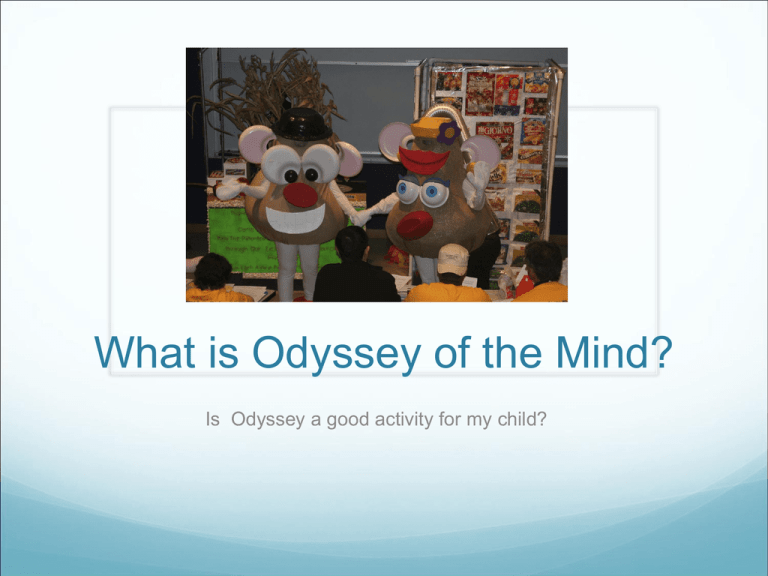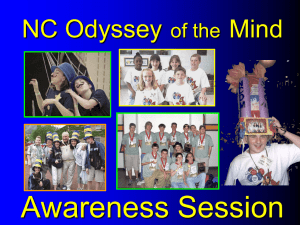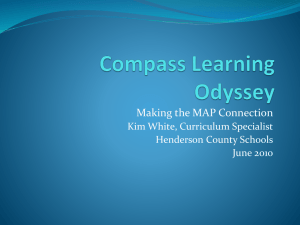CTOM Coach Training Presentation - Connecticut Odyssey of the Mind
advertisement

What is Odyssey of the Mind? Is Odyssey a good activity for my child? Odyssey of the Mind ‘Solving problems with more than one answer.’ “The Odyssey of the Mind teaches students to learn creative problem-solving methods while having FUN in the process.” Odyssey of the Mind Odyssey of the Mind, founded in 1978, is an International creative problem-solving program for students K-12. “The mission of Odyssey of the Mind is to provide creative problemsolving opportunities for every student and to foster original. . .thinking. . . By working in teams, participants learn teamwork, the appreciation and understanding of others, and that a group is more powerful than an individual. They develop a sense of self-respect and respect for others through activities such as role-playing and brainstorming.” “The creative thinking process is nurtured developed as a problem-solving tool.” Odyssey of the Mind Program Guide and Creativity can be taught! “By tapping into creativity, and through encouraging imaginative paths to problem-solving, students develop skills that will provide them with the ability to solve problems– great and small– to last a lifetime.” Odyssey of the Mind The Basics Teams of 5-7 students (K-12) work together under the guidance of adult coaches to solve one of 6 new every year. problems presented Teams compete in one of 4 divisions, Primary (K-2); Division I- grades 3-5; Division II – grades 6-8 and Division III – High School. Student teams from 35 States and over 15 countries work on these problems starting in October, culminating in a State Tournament in March where they compete in their Division (age group). Winning teams advance to the World Finals in May. The students do all of the work- every idea, every word in the script, every prop, device and contraption MUST come from the team of students! Takes the pressure off the coach! The Long Term Problems: 2013-2014 LONG-TERM PROBLEM SYNOPSES All problems have an 8-minute time limit. Problem 1: Driver's Test Divisions I, II, & III For this problem, teams will design, build, and drive a vehicle that will travel a course where a student driver attempts to complete tasks in order to pass a driver’s test. The vehicle will travel using one propulsion system and then travel in reverse using a different propulsion system. The vehicle will encounter a directional signal and have a Global Positioning System (GPS) that talks to the driver. The team will create a theme for the presentation that incorporates the vehicle, a driver’s test, a student, and the talking GPS. Cost limit: $145 USD. Problem 2: The Not-So-Haunted House Divisions I, II, III, & IV The team's problem is to create and present an original performance that includes a "pop-up-style" not-so-haunted "house" where four special effects take place. The intent of the special effects will be to scare others, but they will produce a different result instead. The performance will include at least one character that experiences the special effects and a narrator who relays the experiences to the audience. It will also include a surprise ending. The special effects will be scored for originality and engineering. Cost limit: $145 USD. Problem 3: It’s How We Rule Divisions I, II, III & IV In this Classics problem, teams will re-create a King's Court from history and make their own Royal Court set in an original kingdom at a different time and place. The Historic Court will issue a decree that fits in with its history, while the team-created Royal Court will issue a decree that changes an everyday behavior for the people in the kingdom. The Historic court will be composed as the team wishes, but the original Royal Court will be made up of a leader, a minstrel that performs a song while playing a team-created instrument, and a jester that makes fun of the leader. The performance will include puppets and a Peoplet (a person portrayed as a puppet), and will be scored for humor. Cost limit: $125 USD. Problem 4: The Stackable Structure Divisions I, II, III & IV Teams will design and build a structure made up of separate components stacked on top of one another. The structure components will be made of only balsa wood and glue, and will be tested by balancing and supporting weights after they are stacked. Teams will be scored for the number of components they use in their final structure. Before they are stacked, the separate components will be integrated into an artistic representation of Earth. The team will include the stacking of the components, placement of the weights, and Earth into the theme of its performance. Cost limit: $145 USD. Sponsored by NASA. Problem 5: Seeing is Believing Divisions I, II, III & IV In this problem teams are to create and present an original performance about a community that feels threatened by something in a location it has never visited. The community townspeople will use a creative method to select one or more Travelers to visit and explore the location. While at the location, a Traveler will use a means of communication to send a message home to convince the community that there is nothing to fear. The performance will also include a narrator character, two rhymes about the travels, and a moving set piece. Cost limit: $125 USD. Primary: The World’s First Art Festival Grades K-2 The team's problem is to create and present an original humorous performance about a prehistoric art festival. The festival will include artwork, dance, music, song, and — of course — a team-created audience to experience it all. The team will also create a backdrop that is a replica of a cave painting. Cost limit: $125 USD. The Long Term Problems: The Technical Problems Each problem comes with a set of guidelines and elements, that change every year, which the team must complete. In the technical problems (#1, #2, #4), the teams must design and create a vehicle, a structure or other device, --this robot was designed and built by a team from CHINA For example, in the balsa problem, the team must design and build a structure (as shown below) that is only 8 inches tall, weighs no more than 18 grams (the weight of 3 nickels), out of only balsa wood and glue. The structure will be tested at the competition by how much weight it holds! There are other elements required in the technical problems, usually a performance of some kind. ~350 lbs! The Long Term Problems: The Performance Problems We have performance problems, as well, the Classics and the Performance. These problems also have required elements, for example, maybe the performance needs to include a special character or must be humorous or involve a piece of art work from a given list or take place in a certain place and time. Where do we get materials? Most teams use everyday materials they find at home, or even from the trash! Each problem has its own cost limit so that teams learn to work within a budget. Mrs. Potato Head, here, is made completely from objects commonly found in the home. She costs only a few dollars to make- the rest is imagination! What could YOU make? Spontaneous: The Verbal Spontaneous In addition to the Long Term Problems, at competition, Judges present a problem to the team, one they have never seen before and one which they must solve together as a team within a time limit. For example, a verbal spontaneous might ask the team to: “name things that are blue.” We look for them to go beyond the concrete, ‘my hat’, ‘the sky’, to more creative responses, such as the ‘wind blew’ or ‘I feel blue’ or maybe ‘blueberries.’ What can you think of? Spontaneous: The Hands-On Spontaneous Or the problem may involve manipulating materials, for example the team may be asked to build a the tallest tower using only straws, paper clips, rubber bands, toothpicks and MARSHMALLOWS! Volunteers Connecticut Odyssey of the Mind is an all volunteer organization. All of our Judges, Coaches, even our Board Members donate their time so that the students of Connecticut can benefit from this unique program. Parents, teachers and other community members come forward to help make this happen! Coaches Most of our coaches are parents who want their child to be part of this exciting program. But coaches can be teachers and grandparents. Each team provides their own coach. We encourage new coaches to have a co-coach, which will make the first year easier for everyone. Coaches must be at least 18 years old. COACH TRAINING- We strongly encourage new coaches to attend! We provide two identical sessions, November and January. There are many materials available through CCI (www.odysseyofthemind) and CTOM (www.ctom.org) We are also available to help you during year, whenever you need it! the (assdir@ctom.org) Judges and Volunteers Since we are an all volunteer organization each team MUST provide: • JUDGE- who MUST • attend a day of Judge Training (in late February, early March) • plus a full day at the Tournament in March. Keep in mind, the Judge will not be able to watch the performances- so if this is important to your Judge, pick someone else! But students love to point out to others that their mom or dad is a JUDGE! • VOLUNTEER- who MUST • work at the Tournament for ½ day (no training necessary)runners, door monitors, assisting with parking, etc. Volunteers can watch the performance. Costs: CCI Membership We work hard to keep costs down so that as many students can participate as possible. Odyssey of the Mind is extremely affordable when compared to other activities available to students. 1. First, teams need a membership sponsor- usually a school but can be any established community organization, like a library or church group. 2. Then, the teams need a membership through that organization from CCI (www.odysseyofthemind.com) The membership costs $135 but can cover several teams, 1 in EACH problem in EACH division. CCI provides a full set of problems plus the program guide. Costs: CTOM Registration 3. Registration with Connecticut Odyssey of the Mind (CTOM). By mid/late December, the coach registers the team with CTOM (see www.ctom.org for forms). It is at this point that the Coach will sign up to provide: LONG TERM PROBLEM CHOICE MEMBERSHIP NAME AND NUMBER ONE JUDGE Note: Judges can express a preference for judging: -TECHNICAL, -PERFORMANCE, -SPONTANEOUS or -SCORING ONE VOLUNTEER Register Early for $210.00, Regular registration cost:$245. Late payment fee: $50 See Web site for payment policy and specific dates. Please remember to provide accurate email addresses for everyone as that is how we contact our coaches, judges and other volunteers Costs: The Long Term Problem Each problem has a cost limit that the team must keep recorded for competition. This levels the playing field so that all teams spend the same amount of money on their solution, usually between $125 - $145. For many items, teams can use the tag sale price for things that are commonly available. READ! the Program Guide for a specific list of items exempted from the costs (musical instruments, computers, sound systems). We usually suggest that coaches collect $20- $25 per student to cover the costs of things the team decides they need to buy, hardware, fabric, balsa wood, etc. CTOM State Tournament Teams aim to complete their solutions to the Long Term Problems in time for the CTOM State Tournament in March. At the tournament they will compete in their Long Term Problem and in Spontaneous. Judges are trained to evaluate and assess the solutions and the creativity while following a scoring regimen established by CCI (Creative Competitions, Inc.). Once the team has completed their performance the judging team talks to the team about their performance, examines their props, scenery and devices. This validates the hard work of every team and helps teams develop the ability to explain and describe the work they have just completed. At the end of the competition is the Awards Ceremony! World Finals The top two teams in each problem and division at the CTOM State Tournament advance to the World Finals in May where the top teams from all over the world present their solutions to these same problems. And sometimes CT teams come home having earned a World Finals Trophy! At CTOM We believe that Odyssey of the Mind not only inspires kids, but also prepares skillful, team-playing, out-of-thebox thinkers, leaders ready to meet the challenges of the twenty-first century!” Connecticut Odyssey of the Mind (CTOM) If you are interested, look for more information at www.ctom.org www.odysseyofthemind.org OR CALL us at (860) 219-9799 Email assdir@ctom.org or bwagar@ctom.org Come and have FUN learning at CTOM!







